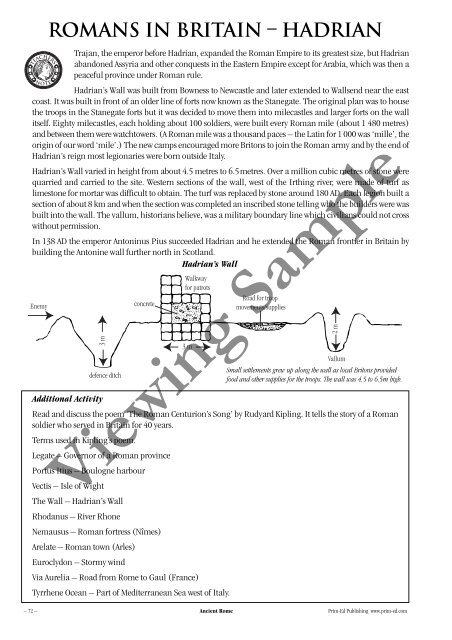Create successful ePaper yourself
Turn your PDF publications into a flip-book with our unique Google optimized e-Paper software.
Romans in Britain – Hadrian<br />
Trajan, the emperor before Hadrian, expanded the Roman Empire to its greatest size, but Hadrian<br />
abandoned Assyria and other conquests in the Eastern Empire except for Arabia, which was then a<br />
peaceful province under Roman rule.<br />
Hadrian’s Wall was built from Bowness to Newcastle and later extended to Wallsend near the east<br />
coast. It was built in front of an older line of forts now known as the Stanegate. The original plan was to house<br />
the troops in the Stanegate forts but it was decided to move them into milecastles and larger forts on the wall<br />
itself. Eighty milecastles, each holding about 100 soldiers, were built every Roman mile (about 1 480 metres)<br />
and between them were watchtowers. (A Roman mile was a thousand paces – the Latin for 1 000 was ‘mille’, the<br />
origin of our word ‘mile’.) The new camps encouraged more Britons to join the Roman army and by the end of<br />
Hadrian’s reign most legionaries were born outside Italy.<br />
Hadrian’s Wall varied in height from about 4.5 metres to 6.5 metres. Over a million cubic metres of stone were<br />
quarried and carried to the site. Western sections of the wall, west of the Irthing river, were made of turf as<br />
limestone for mortar was difficult to obtain. The turf was replaced by stone around 180 AD. Each legion built a<br />
section of about 8 km and when the section was completed an inscribed stone telling who the builders were was<br />
built into the wall. The vallum, historians believe, was a military boundary line which civilians could not cross<br />
without permission.<br />
In 138 AD the emperor Antoninus Pius succeeded Hadrian and he extended the Roman frontier in Britain by<br />
building the Antonine wall further north in Scotland.<br />
Hadrian’s Wall<br />
TEACHERS<br />
N OTE<br />
Additional Activity<br />
Small settlements grew up along the wall as local Britons provided<br />
food and other supplies for the troops. The wall was 4.5 to 6.5m high.<br />
Read and discuss the poem ‘The Roman Centurion’s Song’ by Rudyard Kipling. It tells the story of a Roman<br />
soldier who served in Britain for 40 years.<br />
Terms used in Kipling’s poem.<br />
Legate – Governor of a Roman province<br />
Portus Itius – Boulogne harbour<br />
Vectis – Isle of Wight<br />
The Wall – Hadrian’s Wall<br />
Rhodanus – River Rhone<br />
Nemausus – Roman fortress (Nîmes)<br />
Arelate – Roman town (Arles)<br />
Euroclydon – Stormy wind<br />
Via Aurelia – Road from <strong>Rome</strong> to Gaul (France)<br />
Tyrrhene Ocean – Part of Mediterranean Sea west of Italy.<br />
Viewing Sample<br />
– 72 – <strong>Ancient</strong> <strong>Rome</strong> Prim-Ed Publishing www.prim-ed.com

















